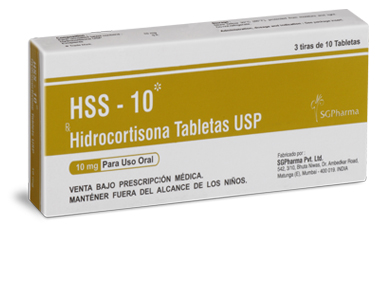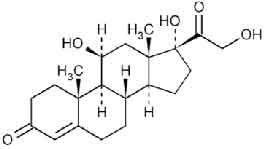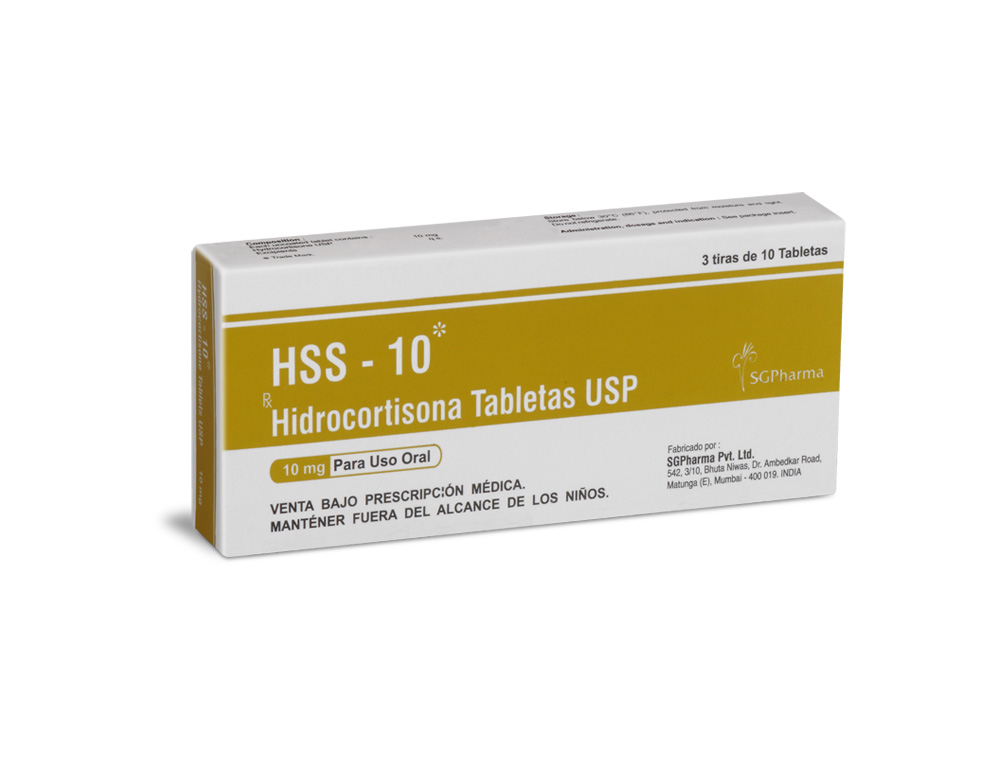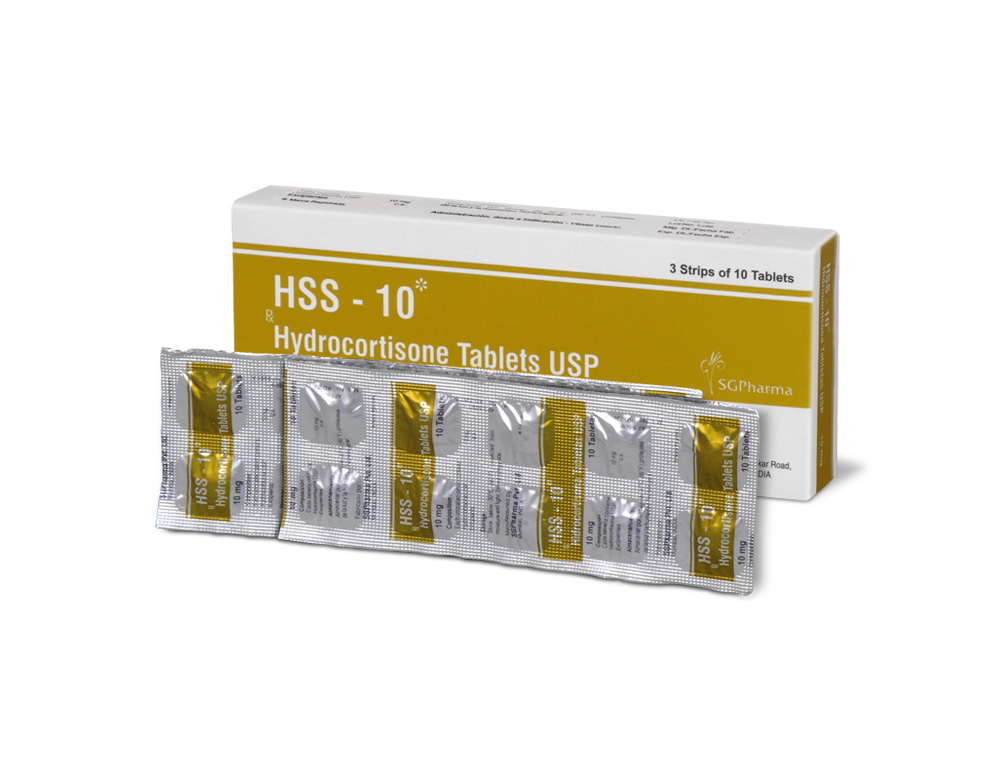
5 mg, 10 mg, 20 mg
For the use of a Registered Medical Practitioner or a Hospital or a Institution only.
HSS (Hydrocortisone) is a glucocorticoid. Glucocorticoids are adrenocortical steroids, both naturally occurring and synthetic, which are readily absorbed from the gastrointestinal tract. Chemically, Hydrocortisone is Pregn-4-ene-3,20-dione,11,17,21-trihydroxy-, (11β)- .The molecular formula is C21H30O5 and molecular weight is 362.46.
STRUCTURAL FORMULA :
Its structural formula is :

HSS tablets are white coloured, circular, flat, uncoated tablet with breakline on one side.
COMPOSITION :
HSS - 10
Each uncoated tablet contains :
Hydrocortisone USP 10 mg
Excipients q.s.
HSS - 20
Each uncoated tablet contains :
Hydrocortisone USP 20 mg
Excipients q.s.
ACTIONS :
Naturally occurring glucocorticoids (hydrocortisone and cortisone), which also have salt-retaining properties, are used as replacement therapy in adrenocortical deficiency states. Their synthetic analogs are primarily used for their potent anti-inflammatory effects in disorders of many organ systems. Glucocorticoids cause profound and varied metabolic effects. In addition, they modify the body’s immune responses to diverse stimuli.
PHARMACOKINETICS :
Hydrocortisone is well absorbed after oral administration achieving peak blood concentrations after one hour. Plasma protein binding is greater than 90%. Hydrocortisone is primarily bound to plasma globulin. Globulins have a high affinity for hydrocortisone but low binding capacity. Plasma albumin may also bind hydrocortisone. Although albumin has a low affinity for hydrocortisone it does have a high binding capacity. Only unbound form of hydrocortisone is pharmacologically active. Hydrocortisone is metabolised in the liver by hydrogenation to tetrahydrocortisone and other degraded forms. These are then excreted in the urine as glucuronide conjugates, with a small proportion of unchanged hydrocortisone. The biological half-life of hydrocortisone is about 100 minutes.
INDICATIONS :
HSS Tablets are indicated in the following conditions :
1. Endocrine Disorders
Primary or secondary adrenocortical insufficiency (hydrocortisone or cortisone is the first choice; synthetic analogs may be used in conjunction with mineralocorticoids where applicable; in infancy mineralocorticoid supplementation is of particular importance)
Congenital adrenal hyperplasia
Non suppurative thyroiditis
Hypercalcemia associated with cancer
2. Rheumatic Disorders
As adjunctive therapy for short-term administration (to tide the patient over an acute episode or exacerbation) in :
Psoriatic arthritis
Rheumatoid arthritis, including juvenile rheumatoid arthritis (selected cases may require low-dose maintenance therapy)
Ankylosing spondylitis
Acute and subacute bursitis
Acute nonspecific tenosynovitis
Acute gouty arthritis
Post-traumatic osteoarthritis
Synovitis of osteoarthritis
Epicondylitis
3. Collagen Diseases
During an exacerbation or as maintenance therapy in selected cases of :
Systemic lupus erythematosus
Systemic dermatomyositis (polymyositis)
Acute rheumatic carditis
4. Dermatologic Diseases
Pemphigus
Bullous dermatitis herpetiformis
Severe erythema multiforme (Stevens-Johnson syndrome)
Exfoliative dermatitis
Mycosis fungoides
Severe psoriasis
Severe seborrhoea dermatitis
5. Allergic States
Control of severe or incapacitating allergic conditions intractable to adequate trials of conventional treatment :
Seasonal or perennial allergic rhinitis
Serum sickness
Bronchial asthma
Contact dermatitis
Atopic dermatitis
Drug hypersensitivity reactions
6. Ophthalmic Diseases
Severe acute and chronic allergic and inflammatory processes involving the eye and its adnexa such as :
Allergic conjunctivitis
Keratitis
Allergic corneal marginal ulcers
Herpes zoster ophthalmicus
Iritis and iridocyclitis
Chorioretinitis
Anterior segment inflammation
Diffuse posterior uveitis and choroiditis
Optic neuritis
Sympathetic ophthalmia
7. Respiratory Diseases
Symptomatic sarcoidosis
Loeffler’s syndrome not manageable by other means
Berylliosis
Fulminating or disseminated pulmonary tuberculosis when used concurrently with appropriate antituberculous chemotherapy
Aspiration pneumonitis
8. Haematologic Disorders
Idiopathic thrombocytopaenic purpura in adults
Secondary thrombocytopaenia in adults
Acquired (autoimmune) haemolytic anaemia
Erythroblastopenia (RBC anaemia)
Congenital (erythroid) hypoplastic anaemia
9. Neoplastic Diseases
For palliative management of :
Leukaemias and lymphomas in adults
Acute leukaemia of childhood
10. Oedematous States
To induce a diuresis or remission of proteinuria in the nephrotic syndrome, without uremia, of the idiopathic type or that due to lupus erythematosus.
11. Gastrointestinal Diseases
To tide the patient over a critical period of the disease in :
Ulcerative colitis
Regional enteritis
12. Nervous System
Acute exacerbations of multiple sclerosis
13. Miscellaneous
Tuberculous meningitis with subarachnoid block or impending block when used concurrently with appropriate antituberculous chemotherapy
Trichinosis with neurologic or myocardial involvement
Administration :
For oral use.
Dosage :
Dosage must be individualised according to the response of the individual patient. The lowest possible dosage should be used. Doses should be multiples of 10 (i.e. 10 mg, 20 mg, 30 mg etc.) The initial dosage of HSS may vary from 20 mg to 240 mg of hydrocortisone per day depending on the specific disease entity being treated. In situations of less severity lower doses will generally suffice while in selected patients higher initial doses may be required. The initial dosage should be maintained or adjusted until a satisfactory response is noted. If after a reasonable period of time there is a lack of satisfactory clinical response, Hydrocortisone Tablets should be discontinued and the patient transferred to other appropriate therapy. IT SHOULD BE EMPHASIZED THAT DOSAGE REQUIREMENTS ARE VARIABLE AND MUST BE INDIVIDUALIZED ON THE BASIS OF THE DISEASE UNDER TREATMENT AND THE RESPONSE OF THE PATIENT. After a favourable response is noted, the proper maintenance dosage should be determined by decreasing the initial drug dosage in small decrements at appropriate time intervals until the lowest dosage which will maintain an adequate clinical response is reached. It should be kept in mind that constant monitoring is needed in regard to drug dosage. Included in the situations which may make dosage adjustments necessary are changes in clinical status secondary to remissions or exacerbations in the disease process, the patient’s individual drug responsiveness, and the effect of patient exposure to stressful situations not directly related to the disease entity under treatment; in this latter situation it may be necessary to increase the dosage of Hydrocortisone Tablets for a period of time consistent with the patient’s condition. If after long-term therapy the drug is to be stopped, it is recommended that it be withdrawn gradually, rather than abruptly.
Multiple Sclerosis :
In treatment of acute exacerbations of multiple sclerosis, daily doses of 200 mg of prednisolone for a week followed by 80 mg every other day for 1 month have been shown to be effective (20 mg of hydrocortisone is equivalent to 5 mg of prednisolone).
CONTRAINDICATIONS :
Hydrocortisone is contraindicated in patients with peptic ulcer, osteoporosis, psychoses or severe psychoneuroses. Hydrocortisone is usually contraindicated in the presence of acute infection, unless the patient is on long term hydrocortisone whereupon the dose should be increased to counteract the increased stress of the infection. HSS contains lactose which is contra-indicated in patients with galactosaemia, the glucose-galactose malabsorption syndrome, or lactase deficiency.
WARNINGS :
In patients on corticosteroid therapy subjected to unusual stress, increased dosage of rapidly acting corticosteroids before, during, and after the stressful situation is indicated. Corticosteroids may mask some signs of infection, and new infections may appear during their use. Infections with any pathogen including viral, bacterial, fungal, protozoan or helminthic infections, in any location of the body, may be associated with the use of corticosteroids alone or in combination with other immunosuppressive agents that affect cellular immunity, humoral immunity, or neutrophil function. These infections may be mild, but can be severe and at times fatal. With increasing doses of corticosteroids, the rate of occurrence of infectious complications increases. There may be decreased resistance and inability to localize infection when corticosteroids are used. Prolonged use of corticosteroids may produce posterior subcapsular cataracts, glaucoma with possible damage to the optic nerves, and may enhance the establishment of secondary ocular infections due to fungi or viruses.
PRECAUTIONS :
General Precautions
Drug-induced secondary adrenocortical insufficiency may be minimized by gradual reduction of dosage. This type of relative insufficiency may persist for months after discontinuation of therapy; therefore, in any situation of stress occurring during that period, hormone therapy should be reinstituted. Since mineralocorticoid secretion may be impaired, salt and/or a mineralocorticoid should be administered concurrently. There is an enhanced effect of corticosteroids on patients with hypothyroidism and in those with cirrhosis.
Corticosteroids should be used cautiously in patients with ocular herpes simplex because of possible corneal perforation. The lowest possible dose of corticosteroid should be used to control the condition under treatment, and when reduction in dosage is possible, the reduction should be gradual.
Psychic derangements may appear when corticosteroids are used, ranging from euphoria, insomnia, mood swings, personality changes, and severe depression, to frank psychotic manifestations. Also, existing emotional instability or psychotic tendencies may be aggravated by corticosteroids. Steroids should be used with caution in non-specific ulcerative colitis, if there is a probability of impending perforation, abscess or other pyogenic infection; diverticulitis; fresh intestinal anastomoses; active or latent peptic ulcer; renal insufficiency; hypertension; osteoporosis; and myasthenia gravis. Growth and development of infants and children on prolonged corticosteroid therapy should be carefully observed. Kaposi’s sarcoma has been reported to occur in patients receiving corticosteroid therapy. Discontinuation of corticosteroids may result in clinical remission.
Although controlled clinical trials have shown corticosteroids to be effective in speeding the resolution of acute exacerbations of multiple sclerosis, they do not show that corticosteroids affect the ultimate outcome or natural history of the disease. The studies do show that relatively high doses of corticosteroids are necessary to demonstrate a significant effect. Since complications of treatment with glucocorticoids are dependent on the size of the dose and the duration of treatment, a risk/benefit decision must be made in each individual case as to dose and duration of treatment and as to whether daily or intermittent therapy should be used. HSS should be used cautiously in diabetic patients.
Pregnancy : Category C
Since adequate information on the effects of hydrocortisone on the developing child is not known, use in pregnancy or in women of child-bearing potential requires that the possible benefit of hydrocortisone to the mother be weighed against the potential hazards to the mother and/or foetus.
Nursing mothers :
Corticosteroids appear in breast milk and could suppress growth, interfere with endogenous corticosteroid production or cause other unwanted effects. Mothers should, therefore, be advised not to nurse if corticosteroids are required. Patients who have received high or prolonged doses of hydrocortisone should be given supplementary corticosteroids to overcome periods of stress caused by anaesthesia, surgery or trauma.
INTERACTIONS :
Consult your doctor for specific advice if you are taking aminoglutethimide, antacids, barbiturates, carbamazepine, griseofulvin, mitotane, phenylbutazone, phenytoin, primidone, rifampin, injectable amphotericin B, oral antidiabetes agents, insulin, digitalis drugs, diuretics, or medications containing potassium or sodium.
SIDE EFFECTS :
The use of hydrocortisone may cause disturbance of electrolyte balance with retention of sodium and water and increased excretion of potassium. There may be disturbances of some aspects of metabolism including gluconeogenesis, calcium balance that may lead to osteoporosis and hyperglycaemia. Tissue repair and healing may be delayed, with an associated increase in the liability for infection. Prolonged administration of hydrocortisone may result in suppression of corticotrophin secretion and atrophy of the adrenal cortex. Large doses of hydrocortisone may produce symptoms typical of cushing’s disease.
MISSED DOSE :
If you take several doses a day and it is close to the next dose, double the next dose. If you take 1 dose a day and you do not remember until the next day, skip the missed dose and do not double the next dose.
OVERDOSAGE :
Symptoms : Fever, muscle or joint pain, nausea, dizziness, fainting, difficulty breathing.
Prolonged overuse : Moonface, obesity, unusual hair growth, acne, loss of sexual function, muscle wasting.
Gastrointestinal : Peptic ulcer with possible perforation and haemorrhage, pancreatitis, abdominal distention & ulcerative oesophagitis.
Dermatological : Impaired wound healing, thin fragile skin, petechiae and ecchymoses, facial erythema, increased sweating & may suppress reactions to skin tests.
Neurological : Increased intracranial pressure with papilledema (psuedotumor crebri) usually after treatment, convulsions, vertigo & headache.
Endocrine : Development of cushingoid state, suppression of growth in children, secondary adrenocortical and pituitary unresponsiveness, particularly in times of stress , as in trauma , surgery or illness, menstrual irregularities, decreased carbohydrate tolerance, manifestations of latent diabetes mellitus & increased requirement for insulin or oral hypoglycaemic agents in diabetics.
Ophthalmic : Posterior subcapsular cataracts, increased intraocular pressure, glaucoma & Exophthalmos.
Metabolic : Negative nitrogen balance due to protein catabolism.
TREATMENT OF OVERDOSAGE :
Treatment is symptomatic and where possible the hydrocortisone dose should be reduced gradually.
STORAGE :
Store below 30°C (86°F), protected from moisture and light.
Do not refrigerate.
SHELF LIFE :
24 months from the date of manufacture.
PRESENTATION :
HSS – 10 tablets contains Hydrocortisone USP 10 mg. 3 strips of 10 Tablets per Box.
HSS – 20 tablets contains Hydrocortisone USP 20 mg. 3 strips of 10 Tablets per Box.
Disclaimer : For the use of a Registered Medical Practitioner or a Hospital or a Institution only. Also it is not intended to be used by healthcare professionals or patients for the purpose of prescribing or administering these products. Questions regarding the complete and current content of product labeling / specification / presentation should be directed to SGPharma.

 Cardiovascular
Cardiovascular








